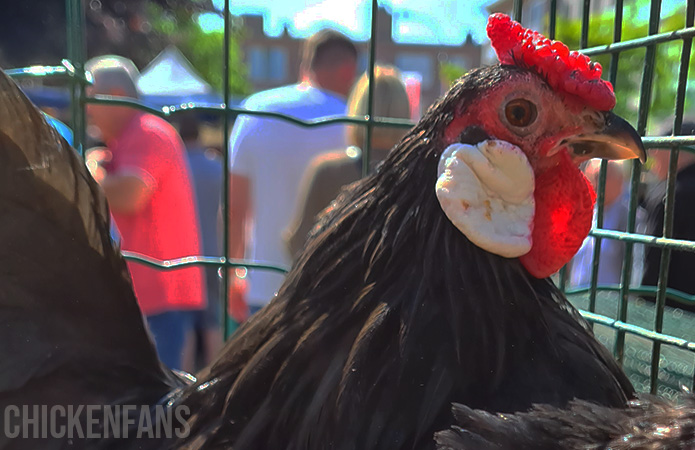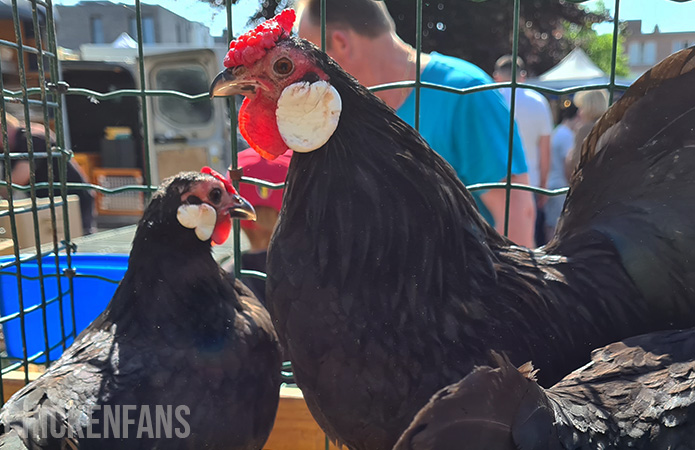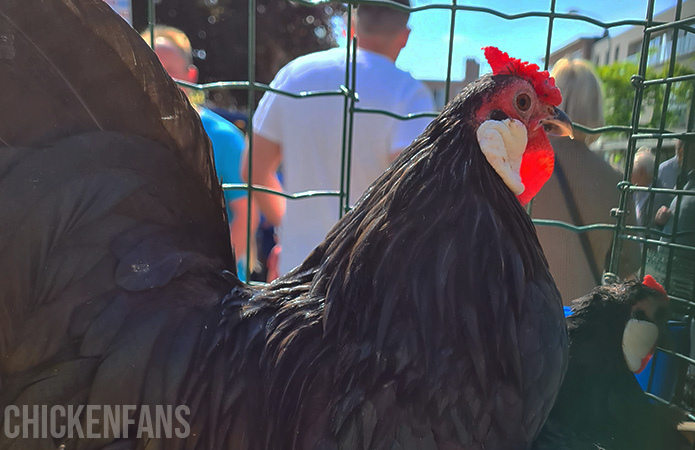Rosecomb Bantam: Tiny Chickens, Big Style

Get ready to meet the star of the poultry runway! Rosecomb bantams have style, flair, elegance and a comb style that will make your heart skip a beat. With a history as rich as their vibrant plumage, they are the crème de la crème of true bantam breeds.
- Rosecomb Bantam hens lay only one egg weekly
- Heritage breed, considered one of the oldest bantam breeds
- Friendly but active and flighty
- Not beginner-friendly, mainly kept by poultry show participants
| Eggs | Up to 100 eggs/year |
| Egg Color | Cream to tinted |
| Egg Size | Tiny |
| Weight | 16 – 22 oz |
| Hardiness | Cold |
| Temperament | Active and flighty |
| Beginner-friendly | No |
| Color | Black, blue and white |
Characteristics
Regarding looks, Rosecomb Bantams are walking works of art. These dainty birds may be small in size, but their style is breathtaking.
Picture this: a compact body perched atop dainty legs. But what really steals the show is their rose comb. This remarkable comb, larger than you’d expect in proportion to its size, sits proudly like a royal crown.
But the glamour doesn’t stop there. Rosecombs boast substantial white earlobes that add a touch of sophistication to their overall appearance, making them resemble like a small and more distinctive type of the White-Faced Black Spanish.
And let’s not forget about their tails, which are a sight to behold. These bantams flaunt tails that are nothing short of prodigious, with feathers that flow and cascade magnificently.

The Rosecomb bantams come in many arrays of hues, with different color variations to choose from. While black is the most commonly seen, the Rosecomb can also be witnessed in blue and white. Other, non-recognized, colors are Barred, Mottled, Lemon Blue, Red Pyle, and Splash.
The males and females of this breed have their own distinct weights. Roosters tip the scales at around 20 to 22 ounces (570 to 620 grams), while hens have a slightly lighter weight of 16 to 18 ounces (450 to 510 grams).
Don’t let their small stature fool you. Rosecombs are far from fragile. These bantams are known for their active nature and flightiness. They enjoy a good fly and are always ready to show their acrobatic talents.
If you’re looking for a lively, animated companion, the Rosecomb Bantams will not disappoint.
Egg Production
Regarding egg production, Rosecomb bantams are not known for being the best egg layers. They prioritize their role as ornamental birds rather than backyard egg layers. If you’re looking for a chicken that will provide you with a steady supply of eggs, Rosecomb Bantams are not the top choice.
Rosecomb bantams are considered poor egg layers, with around one egg per week. Additionally, the size of their eggs is small, as expected from bantam chickens. The eggs they produce are cream-colored or tinted.
While these bantams may not excel in the egg-laying department, they compensate for it with their striking appearance and captivating presence. They are mainly kept as show birds, rather than fulfill the role of egg producers.
Fertility and Breeding Issues
Rosecomb bantam roosters experience reduced fertility in roosters due to a genetic trait associated with their rose comb. Chick mortality after hatching is also higher in Rosecomb Bantams than in other breeds.
Another issue with the breeding process of Rosecombs is that the hens are not especially broody, meaning you’ll need another breed or incubator to successfully hatch the eggs.
Personality
Rosecomb bantams are known for their active nature. These chickens are no wallflowers; they love to strut their stuff and showcase their vibrant presence. They possess an energy that is truly infectious.
Therefore, Rosecombs are not particularly docile chickens. They have an inherent curiosity that keeps them constantly on the move. These bantams are active foragers, always exploring their surroundings and searching for tasty bugs.
Another aspect of their personality is their affinity for flight. They love to spread their wings and take to the skies. They have a strong instinct for flying and can cover impressive distances with their graceful aerial maneuvers. This trait adds an element of dynamism to their character and makes them a delight to watch.

While Rosecombs may not be the cuddliest breed, their lively nature, and engaging personality make them great companions. They bring energy to the flock and provide endless entertainment with their active behavior.
That said, because of their active nature, Rosecomb Bantams are less suited for first-time chicken keepers looking for a calm and cuddly chicken breed.
Breed History
The Rosecomb bantam has a rich history that dates back several centuries. Considered one of the oldest bantam chicken breeds, its origins are traced back to the 14th century in Britain. However, there may be another point of origin as well.
The breed gained popularity as an ornamental breed during the reign of King Richard III, who took a particular interest in raising them. Under his patronage, the Rosecomb bantams began capturing the attention of poultry enthusiasts. This royal company elevated their status and set them on a path to becoming a beloved breed.
The Rosecomb bantams kept their popularity as the centuries progressed, particularly in the 19th century. Their stunning appearance and unique characteristics made them highly desired for exhibition purposes. In fact, Rosecombs were showcased at the first-ever North American poultry exhibition in 1849.
The breed’s significance and standardization were further solidified when it was admitted to the first edition of the American Standard of Perfection in 1874. This recognition ensured that the breed’s qualities and traits were officially documented and preserved for future generations.
Today, Rosecomb Bantams remain one of the most popular bantam breeds, especially with chicken keepers who like to participate in poultry shows.
Summary
The Rosecomb bantam is an ornamental chicken known for its distinctive rose comb. Considered one of the oldest bantam breeds, it has a rich history. While not known for their egg-laying abilities, Rosecombs excel in their striking appearance, featuring large rose combs, prodigious tails, and a compact body shape. These active birds are good fliers and generally hardy, although not the best choice for beginning chicken keepers.






















